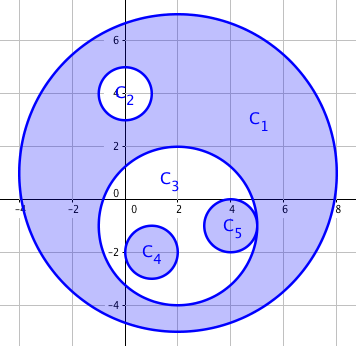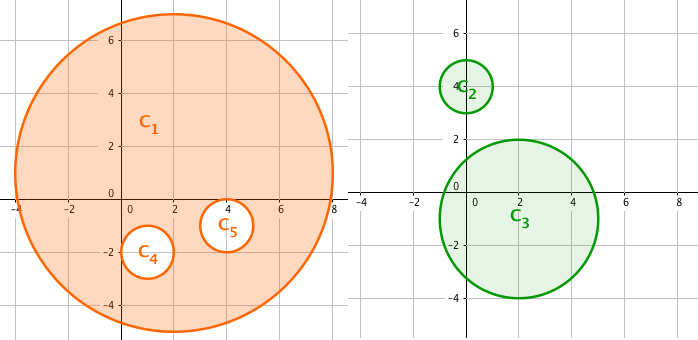codeforces 814D An overnight dance in discotheque(贪心)
来源:互联网 发布:软件语言培训学校 编辑:程序博客网 时间:2024/06/07 10:36
The crowdedness of the discotheque would never stop our friends from having fun, but a bit more spaciousness won't hurt, will it?
The discotheque can be seen as an infinite xy-plane, in which there are a total of n dancers. Once someone starts moving around, they will move only inside their own movement range, which is a circular area Ci described by a center (xi, yi) and a radius ri. No two ranges' borders have more than one common point, that is for every pair (i, j) (1 ≤ i < j ≤ n) either ranges Ci and Cj are disjoint, or one of them is a subset of the other. Note that it's possible that two ranges' borders share a single common point, but no two dancers have exactly the same ranges.
Tsukihi, being one of them, defines the spaciousness to be the area covered by an odd number of movement ranges of dancers who are moving. An example is shown below, with shaded regions representing the spaciousness if everyone moves at the same time.

But no one keeps moving for the whole night after all, so the whole night's time is divided into two halves — before midnight and after midnight. Every dancer moves around in one half, while sitting down with friends in the other. The spaciousness of two halves are calculated separately and their sum should, of course, be as large as possible. The following figure shows an optimal solution to the example above.

By different plans of who dances in the first half and who does in the other, different sums of spaciousness over two halves are achieved. You are to find the largest achievable value of this sum.
The first line of input contains a positive integer n (1 ≤ n ≤ 1 000) — the number of dancers.
The following n lines each describes a dancer: the i-th line among them contains three space-separated integers xi, yi and ri( - 106 ≤ xi, yi ≤ 106, 1 ≤ ri ≤ 106), describing a circular movement range centered at (xi, yi) with radius ri.
Output one decimal number — the largest achievable sum of spaciousness over two halves of the night.
The output is considered correct if it has a relative or absolute error of at most 10 - 9. Formally, let your answer be a, and the jury's answer be b. Your answer is considered correct if  .
.
52 1 60 4 12 -1 31 -2 14 -1 1
138.23007676
80 0 10 0 20 0 30 0 40 0 50 0 60 0 70 0 8
289.02652413
The first sample corresponds to the illustrations in the legend.
题意:有n个人跳舞,然后每个人跳舞的区域是一个圆,圆与圆不想交。然后现在把这些人分成白天和黑夜跳舞的两批。如果一个人跳舞的区域被覆盖奇数次,他的面积就需要被减去,被覆盖偶数次他的面积就会被加上,然后现在问你跳舞合适的最大面积是多少。
分析:对于每个圆,我们O(n)地算一遍它能包含哪些圆,然后把能被包含的圆的层数+1。
ans=s(1)+s(2)-s(3)+s(4)-s(5)+...,即加上1号圆的面积,对于后面的圆偶数编号的加上,奇数编号的减去
#include<bits/stdc++.h>using namespace std;#define pi acos(-1)struct Node{ double x, y, r; int num;}a[1005];bool cmp(Node p, Node q){ return p.r > q.r;}bool judge(Node u, Node v){ return (u.x - v.x)*(u.x - v.x) + (u.y - v.y)*(u.y - v.y) < (u.r + v.r) * (u.r + v.r);}double cal(Node u){ return u.r * u.r * pi;}int main(){ int n; scanf("%d", &n); for(int i = 1; i <= n; i++) scanf("%lf%lf%lf", &a[i].x, &a[i].y, &a[i].r); sort(a+1, a+n+1, cmp); for(int i = 1; i <= n; i++) for(int j = i+1; j <= n; j++) if(judge(a[i], a[j])) a[j].num++; double ans = 0; for(int i = 1; i <= n; i++) if(!a[i].num) ans += cal(a[i]); else if(a[i].num & 1) ans += cal(a[i]); else ans -= cal(a[i]); printf("%.8f\n", ans); return 0;}- codeforces 814D An overnight dance in discotheque(贪心)
- Codeforces-814D An overnight dance in discotheque(贪心)
- Codeforces 814D-An overnight dance in discotheque 贪心
- coderforces 814 D. An overnight dance in discotheque(贪心)
- codeforces D. An overnight dance in discotheque
- codeforces 814D An overnight dance in discotheque
- codeforces 814D An overnight dance in discotheque(思维)
- Codeforces 814D An overnight dance in discotheque DP(树形)
- Codeforces 814D-An overnight dance in discotheque
- Codeforces 814D An overnight dance in discotheque【思维】
- codeforces 814 D An overnight dance in discotheque
- [Codeforces 814D] An overnight dance in discotheque 树形dp,贪心
- Codeforces Round #418 (Div. 2) D. An overnight dance in discotheque(思维 贪心)
- codeforces 814D An overnight dance in discotheque(几何思维)
- Codeforces Round #418 (Div. 2) D. An overnight dance in discotheque 贪心
- D. An overnight dance in discotheque
- 贪心——Codeforces814D An overnight dance in discotheque
- CF#418 Div2 D. An overnight dance in discotheque
- Oozie bundle定时调度多job
- Android音视频API(android.media.audiofx):概览
- CString和string的相互转换
- python datetime 以及如何用%s来调用
- linux系统配置序列号
- codeforces 814D An overnight dance in discotheque(贪心)
- 46 《未来的工作》 -豆瓣评分7.0
- Linux下修改tomcat JVM内存大小
- Scala入门到精通——第二十七节 Scala操纵XML
- Trailing Zeroes (III) (数学)
- Jlink接口的Jtag和SWD接口定义
- openstack及其核心项目
- Maven学习笔记----使用Maven创建Java项目
- ArcGIS9.3 插件开发的dll如何在ArcMap等桌面端产品用起来


